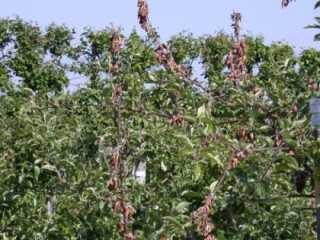
- The fungus attacks flowers causing them to wilt turn brown and collapse.
- The symptoms appear from petal fall onwards.
- The outer bark of infected spurs is discoloured and the underlying tissues necrotic.
- Grey pustules of mycelium and spores develop on the affected flower parts. Wilted blossoms have a distinctive fetid smell, similar to the scent of sweet chestnut flowers.
- The fungus progresses from infected flowers down through the spur into branches and forms cankers characterised by brown zones of infection (water marking).
- Similar grey pustules develop on cankers.
- On cider apples often only the blossom is killed and the fungus does not progress much into the spur so the only symptom is dead blossoms.
Other problems that may be confused with blossom wilt
Blossom
Wilting blossoms may be caused by other diseases such as Neonectria canker, where canker further down the branch results in wilting blossoms above.
- This may be distinguished by the absence of grey pustules, internal rotting of the blossom truss and the distinctive smell.
- Similarly fireblight can also cause wilting/dead blossoms. In this case milky-coloured bacterial ooze is associated with the affected blossoms.
- Fireblight is more likely to be confused with blossom wilt in cider apple varieties as these flower later than culinary and dessert varieties and are therefore more subject to fireblight attack.
- Wilting blossoms can also result from attack by bud moth (Spilonota ocellana).
- Careful examination of such affected blossoms should reveal evidence of mining by bud moth larvae.
Cankers
Blossom wilt cankers can be confused with other cankers such as those caused by Neonectria ditissima.
- These can be distinguished by the presence of white/creamy pustules or the red pinhead-sized fruiting bodies (perithecia) of N. ditissima and absence of water marking.
- Fireblight cankers at the base of a flower spur may also resemble those of blossom wilt.
- Cankers caused by brown rot (Monilinia fructigena) are very similar to those of blossom wilt fungus and only differ in the colour of pustules: cream for brown rot and grey for blossom wilt. These are probably only distinguishable by an expert.
